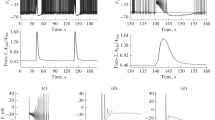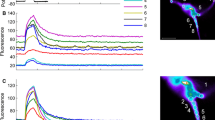Abstract
Calcium channels in excitable membranes are essential for many cellular functions. Recent analyses of the burst-firing mode of some vertebrate neurones1–3 suggest that changes in their functional state are controlled by a Ca conductance that is largely inactivated at resting membrane potentials (−50 to −60 mV), but becomes activated following a conditioning hyperpolarization of the cell membrane. Here, using chick and rat sensory neurones, we present evidence for a new type of Ca channel with time- and voltage-dependent properties which is probably responsible for the inactivation behaviour of the Ca conductance. At membrane potentials between −50 and +10 mV, openings of this channel last 3–6 ms and tend to occur in rapid succession. Inactivation of this channel is indicated by prolonged and eventually complete closures brought about by long-lasting depolarizing voltage steps. This channel coexists in isolated membrane patches with the more common Ca channel4 which is less sensitive to changes in holding potential and shows a considerably shorter average life time and smaller currents.
Similar content being viewed by others
References
Llinas, R. & Yarom, Y. J. Physiol., Lond. 315, 569–584 (1981).
Llinas, R. & Jahnsen, H. Nature 297, 406–408 (1982).
Jahnsen, H. & Llinas, R. J. Physiol., Lond. 349, 205–226 (1984).
Brown, A. M., Camerer, H., Kunze, D. L. & Lux, H. D. Nature 299, 156–158 (1982).
Barde, Y. A., Edgar, D. & Thoenen, H. Proc. natn. Acad. Sci. U.S.A. 77, 1199–1203 (1980).
Horn, R. & Patlak, J. B. Proc. natn. Acad. Sci. U.S.A. 77, 6930–6934 (1980).
Hamill, O. P. & Sakmann, B. J. Physiol., Lond. 312, 41P–42P (1981).
Hamill, O. P., Marty, A., Neher, E., Sakmann, B. & Sigworth, E. F. J. Pflügers Arch. ges. Physiol. 391, 85–100 (1981).
Carbone, E. & Lux, H. D. Biophys. J. (in the press).
Fenwick, E. M., Marty, A. & Neher, E. J. Physiol., Lond. 331, 599–635 (1982).
Adams, D. J. & Gage, P. W. J. Physiol., London. 291, 467–481 (1979).
Lux, H. D. & Brown, A. M. J. gen. Physiol. 83, 727–750 (1984).
Hagiwara, S. & Byerly, L. A. Rev. Neurosci. 4, 69–125 (1981).
Lux, H. D. in Single-Channel Recording (eds Sakmann, B. & Neher, E.) 437–449 (Plenum, New York, 1983).
Nagy, K., Kiss, T. & Hof, D. Pflügers Arch ges. Physiol. 399, 302–308 (1983).
Hagiwara, S., Ozawa, S. & Sand, O. J. gen. Physiol. 65, 617–644 (1975).
Author information
Authors and Affiliations
Rights and permissions
About this article
Cite this article
Carbone, E., Lux, H. A low voltage-activated, fully inactivating Ca channel in vertebrate sensory neurones. Nature 310, 501–502 (1984). https://doi.org/10.1038/310501a0
Received:
Accepted:
Issue Date:
DOI: https://doi.org/10.1038/310501a0
- Springer Nature Limited





